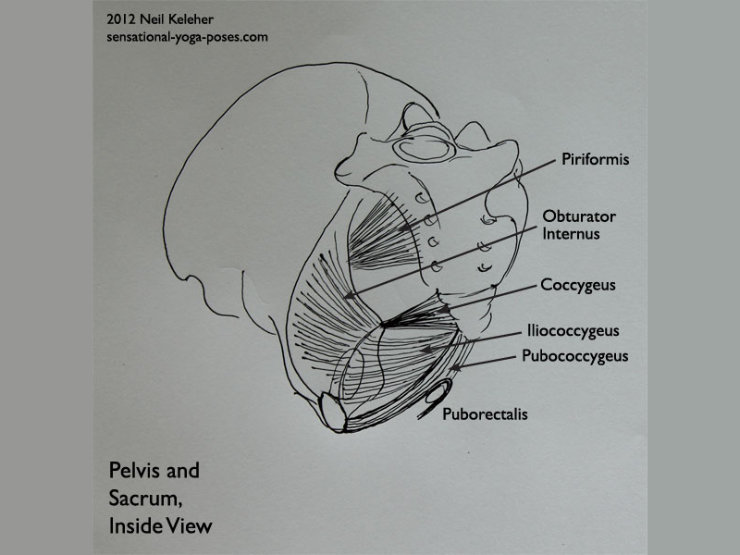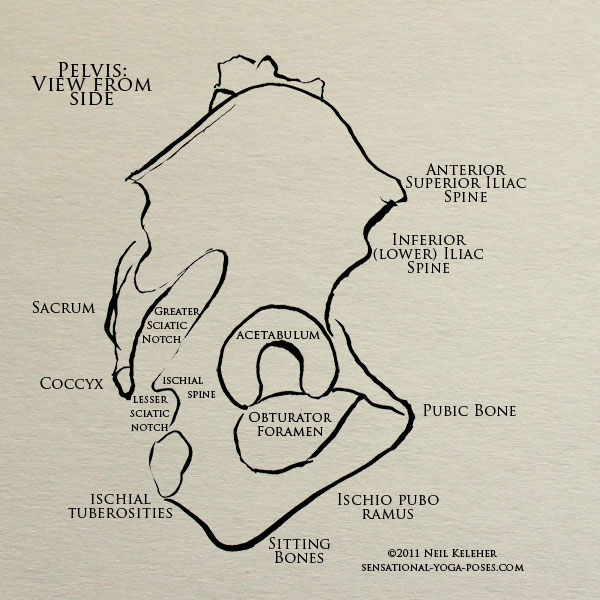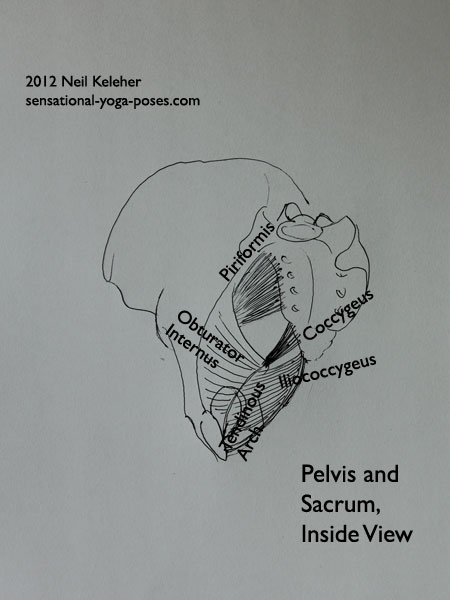The PC Muscle
Consciously Controlling Pubococcygeus and other Muscles of the Pelvic Diaphragm"
The PC muscle is one of the main muscles of the pelvic diaphragm. It connects from the tailbone at the bottom of the sacrum to the pubic bone.
It's because of this connection to the bottom of the tailbone that you can learn to consciously control it.
Most instructions for activating the PC muscle describe "stopping the flow of urine" but another instruction for consciously activating it is pulling the tailbone towards the pubic bone. Rather than tilting the pelvis backwards to move the tailbone forwards, keep the pelvis still and move your tailbone towards your pubic bone (which is at the front of the pelvis.)
When doing this you may actually feel your tail bone moving forwards slightly.
The Pelvic Floor Muscles
The PC muscle is part of a larger set of muscles that includes the coccygeus, iliococcygeus, puborectalis and levator prostatae (men) or levator vaginae (women.)
Each of these pelvic floor muscles have specific points of attachments, landmarks that can be used to help both activate these muscles specifically and to relax them.
Deeper control and awareness of the pelvic diaphragm can be the result. This same control may help you in going deeper into your yoga poses or at the very least being more mindfully while doing them
Control (and Sensitivity) is the Goal
The goal of learning to contract these muscles, PC muscle includes, is not to hold them contracted, but to be able to contract them and release them at will. You may then notice when you are overly "tight" without needing to be so. And you can also then choose to engage if what you are doing requires you to do so.
In a yoga pose context, greater sensitivity of the PC muscles and other muscles of the pelvic diaphragm can give better control of the SI joint, meaning control of how the sacrum and pelvis relate. It can also give a better sense of mula bandha.
Learning to relax and contract the PC muscle (and the rest of the pelvic floor) can be a starting point for developing better pelvic floor awareness.
But before we continue it's a good idea to get to know some potential landmarks of the pelvis.
Pelvic Landmarks
The Ischial Spine
If you are up on your hip anatomy then you know that the upper sciatic notch is the gap that the piriformis passes through as it runs from the front of the sacrum to the top of the thigh bones. The lower sciatic notch is the gap that the obturator internus wraps around.
The obturator internus attaches to the inside of the pelvis. It wraps around the back of the pelvis at the lower sciatic notch and then reaches forwards and up to attach to the top of the thigh bone. Meanwhile the piriformis passes from the sacrum to the thigh bone just above it.
The ischial spine acts as a sort of separator between the piriformis and the obturator internus where they both cross the back of the pelvis.
Piriformis and obturator internus aside, the ischial spine is just above (and behind) the sitting bone. The sitting bone then serves as a useful reference for learning to find and activate the coccygeus muscle.
The Tendinous Arch
Another important landmark is the tendinous arch. This arch of connective tissue runs from the ischial spine to the pubic bone and arches over the obturator internus muscle as it does so.
It's important because from the tailbone, the iliococcygeus muscle attaches to it.
The Anus and Perineum
Next as landmarks are the anus and the point just in front of the anus which I'll term the perineum.
The levator ani, which attaches to the back of the pubic bone, loops around the anus meaning that it can be used to pull the anus forwards. Meanwhile, looping in front of the anus is the levator prostatae/vaginae.
All of the above landmarks are important since they give clues on how to activate the individual muscles of the pelvic diaphragm.
Activating the Muscles of the Pelvic Diaphragm
I've already mentioned that to activate the PC muscle, all you have to do is pull the tailbone towards the pubic bone. You do this without moving the pelvis. To add to this pull forwards on the anus to activate levator ani. Then pull forwards on the perineum to activate levator prostatae or vaginae.
If you like you could also add a slight uddiyana bandha to this action by pulling inwards on the lower belly just above the pubic bone. Try to inhale while keeping all of these muscles active and then as you exhale gradually relax them completely.
To add coccygeus and ilio coccygeus, pull inwards on the sitting bones and then extend the tension forwards to the pubic bone. Play with the sequence in which you activate these muscles. You might try activating the center line first and then the more lateral coccygeus and iliococcygeus. Or try first activating the PC muscle, then the lateral muscles, then levator ani and prostatae/vaginae.
You can also try "sequenced" release of all of these muscles or simply relax them all together, but slowly and smoothly.
Note that although piriformis isn't part of the pelvic floor (though it closely relates) you could also try activating this muscle by pulling forwards on the sacrum. It can feel like "sucking" the sacrum forwards.
I'd suggest doing this after activating the other muscles.
The PC Muscle and Back Bends
One general type of yoga posture where you may find it beneficial to activate the pelvic floor muscles is in backbending poses like bridge pose, wheel pose or any other yoga pose where the front of the hip joint is opened.
One way that I like to think about it is that by activating the pelvic floor muscles, particularly coccygeus, the sitting bones are pulled inwards and this gives the thighs room to move backwards (past the sitting bones.)
This could be thought of as being similiar to the outer edges of the shoulder blades moving upwards to accommodate and up-over-the-head arm position.
A more probable reason for moving the sitting bones inwards is that is redistributes tension among the hip muscles so that the hip joints are still stable (and controllable) even near their limits of movement.
From my experiences so far I'd suggest that hip stability can best be created in back bends (particularly wheel pose) by activating the entire pelvic floor (as discussed above) along with the piriformis, maybe the obturator internus, the iliacus and the psoas.
For more on the opposite action (which could be called a Reverse Kegal) read SI Joint Exercises.





